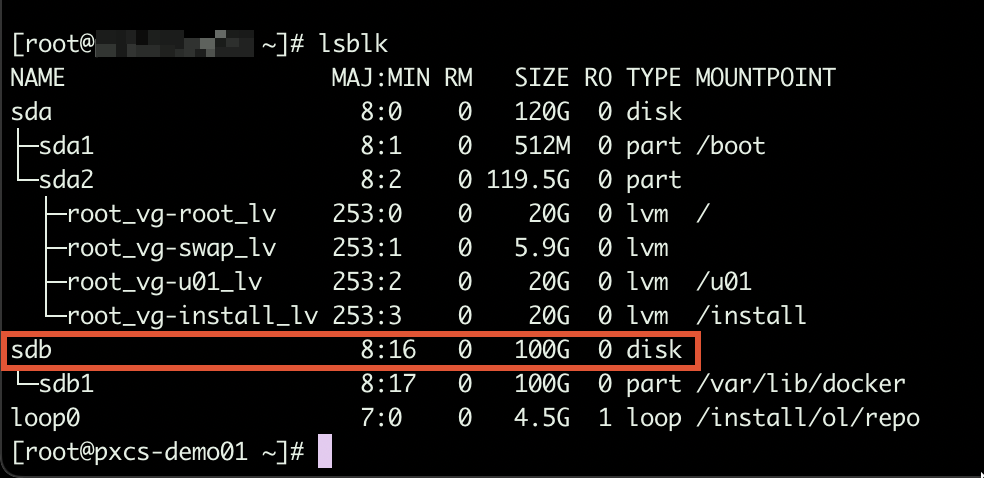OS Tools
-
Linux Logical Volume Management
Table of Contents
Creating a logical volume and volume group
- Make sure the physical disk is listed as block device

Checking block devices with lsblk - Create a new primary partition on the disk (partition type = 8e)
fdisk /dev/sdx # Replace "sdx" with your block device real name n # create new partition p # New primary partition 1 # select Partition number (1-4) <Enter> # partition size: Accept the default values in case you want to use the full disk available space t # set partition type LVM linux is 8e 1 # select partition 8e # for linux lvm w # to write
- Create a new physical volume related to the partition created above
# Physical volume creation (Replace sdx with your block device name) pvcreate /dev/sdx1
- Create a new volume group and include the pv mentioned above to it
vgcreate testdata_vg /dev/sdx1
- Create a new logical volume as child of the volume group above, you can specify a constant size or use 100% of the volumes currently part of the volume group above
Sample 1: New logical volume with size 20 GB lvcreate -L 20000 -n vol01 testdata_vg Sample 2: New logical volume using 100% of available space lvcreate -l 100%FREE -n vol01 testdata_vg
- Format the logical volume created above
Sample: Format as ext4 mkfs.ext4 /dev/testdata_vg/vol01
You can now mount the volume (device name: /dev/testdta_vg/vol01).
Extending an exiting logical volume
Adding an extra disk
- Make sure the new disk is listed as block device (lsblk)
- Create a new partition on the new disk and set the type to 8e (see instructions above)
- Create a new physical volume
pvcreate /dev/sdx1
- Extend the volume group adding the new pv to the volume group
vgextend /dev/testdata_vg /dev/sdx1
- Extend the logical volume so that is can use all space available now on the volume group
lvextend -l +100%FREE /dev/testdata_vg/vol01
- Double check that the new volume is now part of the existing volume group (lsblk)
- Unmount the volume group
umount /your_volume_group_mount_point
- Check the file system integrity (ext filesystems only)
e2fsck -f /dev/testdata_vg/vol01
- Extend the file system (command for ext file systems)
resize2fs /dev/testdata_vg/vol01
- Extend the file system (command for xfs file systems)
Make sure that volume group is mounted before to issue the command below
xfs_grows /dev/testdata_vg/vol01
- Mount the drive (if not already mounted . . .)
mount /your_volume_group_mount_point
- Double check that now the volume group is using all new available disk space
df -h
Adding extra space added to an already existing disk
- Check the current partitions on extended physical disk
fdisk -l /dev/sdx
- Create a new primary partition and set type to 8e (see instructions above)
- Create a new physical volume
- Extend the volume group adding the new physical volume to the volume group
vgextend /dev/testdata_vg /dev/sdx1
- Extend the logical volume so that is can use all available size of the volume group
lvextend -l +100%FREE /dev/testdata_vg/vol01
- Check the integrity (ext file systems only)
e2fsck -f /dev/testdata_vg/vol01
- Extend the file system (command for ext file systems)
resize2fs /dev/testdata_vg/vol01
- Extend the file system (command for xfs file systems)
Make sure that volume group is mounted before to issue the command below
xfs_grows /dev/testdata_vg/vol01
- Mount the drive (if not already mounted . . .)
mount /your_volume_group_mount_point
- Double check that now the volume group is using all new available disk space
df -h
Troubleshooting
mkfs command takes a very long time
To run mkfs without trim, use the -K option on XFS and -E nodiscard on ext4.
XFS:
mkfs.xfs -K /dev/sdx
EXT4:
mkfs.ext4 -E nodiscard /dev/sdx
lsblk/df does not show volume changes
Reload the partition table with the command ‘partprobe’
A new disk has been attached to the VM, but it’s not listed as block device
Option #1: Reboot the VM
Option #2: Force the OS to scan list of attached block devices:
for host in /sys/class/scsi_host/*; do echo "- - -" | sudo tee $host/scan; ls /dev/sd* ; done
-
Accessing a webdav drive from Linux shell
Table of Contents
Option 1: Connect on an interactive session
Pre-requisites
- You need to retrieve the webdav URL from your provider. Sample:
https://testportal.com/remote.php/dav/files/your_username/- Install command line tool “cadaver” (installation method depends on your Linux distribution)
Connecting via “cadaver”
cadaver https://testportal.com/remote.php/dav/files/your_username/You will be prompted to provide your password. Once logged in, you will be connected to a webdav shell.
Available commands
ls [path] List contents of current [or other] collection cd path Change to specified collection pwd Display name of current collection put local [remote] Upload local file get remote [local] Download remote resource mget remote... Download many remote resources mput local... Upload many local files edit resource Edit given resource less remote... Display remote resource through pager mkcol remote... Create remote collection(s) cat remote... Display remote resource(s) delete remote... Delete non-collection resource(s) rmcol remote... Delete remote collections and ALL contents copy source... dest Copy resource(s) from source to dest move source... dest Move resource(s) from source to dest lock resource Lock given resource unlock resource Unlock given resource discover resource Display lock information for resource steal resource Steal lock token for resource showlocks Display list of owned locks propnames res Names of properties defined on resource chexec [+|-] remote Change isexecutable property of resource propget res [propname] Retrieve properties of resource propset res propname value Set property on resource set [option] [value] Set an option, or display options open URL Open connection to given URL close Close current connection quit Exit program unset [option] [value] Unsets or clears value from option. lcd [directory] Change local working directory lls [options] Display local directory listing lpwd Print local working directory logout Logout of authentication session help [command] Display help messageOption #2: Mount the remote webdav as a local folder
I find this method much more convenient.
- Install davfs file system drivers
- apt-get install davfs2 or yum install davfs2
- Add your local user to “davfs” group
- usermod -aG davfs2 <username>
- Create a local folder to use as mount point
- mkdir /yourmountpoint
- Create a folder to store your users’s davfs settings
- mkdir ~/.davfs2
- Copy davfs global settings to your user’s folder
- cp /etc/davfs2/secrets ~/.davfs2/secrets
- Add an entry to /etc/fstab:
https://testportal.com/remote.php/dav/files/your_username/ /yourmountpoint davfs user,rw,noauto 0 0- Mount the share
- mount /yourmountpoint
-
Linux swap partition management
Table of Contents
Creating a new swap space from a new disk
- Format the new partition with:
mkswap /dev/sdx1- Add the new swap partition to /etc/fstab
/dev/sdx1 swap swap defaults 0 0- Run swapon -a to activate the new swap.
Creating a new swap file
Create the file. This command creates a 1 gigabyte file:
dd if=/dev/zero of=/swap bs=1M count=1000Format the swap file:
mkswap /swapAdd the new swap file to /etc/fstab:
/swap swap swap defaults 0 0Run swapon -a to activate immediately the new swap space.
Deactivating an existing swap space
- Run “swapoff -a“
- Comment / delete the related entry on file /etc/fstab
/dev/sdx1 swap swap defaults 0 0 -
(My) rsync cheatsheet
Table of Contents
Sync folder using 5 parallel threads
ls -1 /testdata/testdb | xargs -I {} -P 5 -n 1 rsync -avh /testdata/testdb/{} root@10.64.4.3:/testdata/testdb_from_aio01/Sync content from folder A to folder B
If you want the contents of folders A and B to be the same, put /home/user/A/ (with the slash) as source. By doing so, all folder A’s content will end up into folder B.
Like this:
rsync --progress -avuzp --delete "/home/user/A/" "/home/user/B"
Arguments:
-a Do the sync preserving all filesystem attributes -v run verbosely -u only copy files with a newer modification time (or size difference if the times are equal) --delete delete the files in target folder that do not exist in the sourceSync content (including symlinks) from source to destination host via SSH
rsync --progress -avuzhp /source/dir root@DESTINATION_HOST_IP_ADDRESS:/destination/dir
-
Nginx tips
Table of contents
Redirect rules
Setting up maintenance page based on file presence
First of all, determine which configuration file is being used by checking the main nginx configuration file.
This can be retrieved by looking into nginx service startup arguments. Typically: /etc/nginx/nginx.conf
Extract from nginx.conf:
. . . include /etc/nginx/sites-enabled/*; . . .
Based on the configuration statement above, we need to look into all files into folder /etc/nginx/sites-enabled
Sample configuration file:
... server { listen 10.64.4.7:443 ssl; client_max_body_size 1024M; server_name test.demo test; root /opt/customer/test/apps/angular/angular; if (-f $document_root/themes/components/login/maintenance.html) { return 503; } error_page 503 @maintenance; expires 168h; add_header Content-Security-Policy "frame-ancestors 'self'"; add_header Cache-Control "no-cache"; add_header X-Frame-Options SAMEORIGIN; add_header Strict-Transport-Security "max-age=31536000; includeSubDomains" always; add_header X-Content-Type-Options nosniff; add_header X-XSS-Protection "1; mode=block"; add_header Referrer-Policy "same-origin"; index index.html index.htm; ssl_certificate /etc/nginx/cert/test.crt; ssl_certificate_key /etc/nginx/cert/test.key; ssl_session_cache builtin:1000 shared:SSL:10m; ssl_protocols TLSv1.2; ssl_ciphers " ECDHE-RSA-AES256-SHA:DHE-RSA-AES256-SHA:ECDHE-RSA-AES128-SHA:DHE-RSA-AES128-SHA:ECDHE-RSA-AES256-GCM-SHA384:DHE-RSA-AES256-GCM-SHA384:ECDHE-RSA-AES256-SHA384:ECDHE-RSA-AES128-GCM-SHA256:DHE-RSA-AES256-SHA256:DHE-RSA-AES128-GCM-SHA256:ECDHE-RSA-AES128-SHA256:DHE-RSA-AES128-SHA256 "; ssl_prefer_server_ciphers on; ssl_dhparam /etc/ssl/certs/dhparam.pem; access_log /var/log/nginx/access.log main; error_log /var/log/nginx/error.log; rewrite ^/$ /webconnect; location @maintenance { rewrite ^(.*)$ /themes/components/login/maintenance.html break; } ...Sections on lines 8 – 11 and 33 – 35 state what must be done whenever a given file on a path is available or not. If positive, nginx will redirect all requests to the @maintenance location (a maintenance page).
Logging
Log rotation settings
Configuration file: /etc/logrotate.d/nginx
Sample configuration (keeps last 30 days):
/var/log/nginx/*log { daily <--- rotates on a daily basis rotate 30 <--- last 30 logs missingok notifempty compress sharedscripts postrotate /bin/kill -USR1 $(cat /var/run/nginx.pid 2>/dev/null) 2>/dev/null || : endscript }







